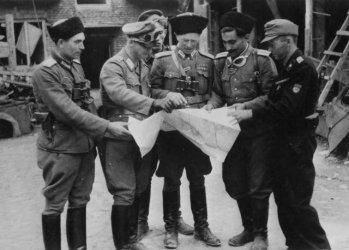
A meeting of the Cossack officers
The Foreigners in the Warsaw Uprising 1944
The German Collaborators
The German forces located in Warsaw in 1944 just before the outbreak of the uprising included numerous collaborative units consisting mainly of former citizens of the Soviet Union.
It were:
- 209th Cossack Battalion Schutzmannschaften (auxiliary police), formed from independent companies 3 months before the uprising
- 572nd infantry Cossack Battalion commanded by Colonel Zinoviev
- 69th Cossack Battalion
- 580 Squadron of the Cossack Cavalry Osttruppen
- 34th SS Police Regiment, which had two German-Ukrainian battalions
Soldiers from these units came mainly from Eastern Ukraine, most of them did not speak Polish.
There were also two Ukrainian police companies in Warsaw (probably a part of the Ukrainian Waffen SS Division Galizien-Hałyczyna) and a Ukrainian formation in the Pawiak prison guard.
Immediately after the outbreak of the uprising, the Germans began to organize help to the fighting units of the Warsaw garrison and to the front units of the 9th Army caught by surprise during their march through Warsaw.
The Korpsgruppe von dem Bach was created, which included:
- Rohr Combat Group
- Reinefarth Combat Group
- Schmidt Assault Group
- Directly subordinated units
In the first phase there was a total of about 6,000 Wehrmacht soldiers, 4,300 SS-men, police officers and the Security Service and arriving units.
The first units of the "relief" arrived in Warsaw around August 4, 1944.
In addition to the German troops, the Korpsgruppe von dem Bach was made up of numerous collaborators.
In the Rohr Combat Group there was, among others:
- 4th squadron of the 580th Cossack Cavalry Regiment
- 209th Cossack Battalion Schumma
- Assault Group RONA - Kaminski's Brigade incarnated in the SS as a SS-Brigade
The Dirlewanger Assault Team, also known as the Dirlewanger Brigade, which was a part of the Reinefart Combat Group, included:
- 3rd Cossack Regiment
- a battalion of the Bergman Regiment (Azerbaijani)
- 1st Battalion of the 111th Azerbaijani Regiment
In the Schmidt Assault Group, there were, among others:
- 4th Battalion of the 57th Cossack Regiment
- support platoon of the 111th Azerbaijani regiment
In subordinated units directly in the shield group:
- 572nd Battalion of Cossacks
- 69th Battalion of Cossacks
- 580th Cossack Cavalry Regiment
- 34th SS Police Regiment which had two German-Ukrainian battalions
The Corps was joined later by:
- 579th Cossack Battalion
- 580th squadron of the Cossack cavalry
Cossack units were used mainly for the outer blockade of the city.

A meeting of the Cossack officers
Among the collaborative units, foreigners serving in the Kaminski's RONA Brigade and Azerbaijani military formations gained particularly bad fame.
RONA had its beginning in a collaborative anti-Soviet people's militia created at the end of 1941 in the area of the so-called Lokot Republic founded by the Germans in conquered Russian areas near Oryol. Converted to the Russian National Liberation Army at the beginning of 1943, it reached almost 10,000 people. Colloquially, it was called the Kaminski Brigade. The commander, Bronislav V. Kaminski, received the general rank from the Germans.
In the second half of 1943, retreating from the approaching front, the RONA brigade found itself in Belarus. A supplementary mobilization and volunteer recruitment was carried out there. Throughout its existence the brigade fought bitterly against the Soviet partisans, supporting the actions of the Germans. In the spring of 1944 the brigade found itself in the Polish lands near Grodno. In July it was withdrawn to the area of Częstochowa and then to the Raciborz area.
At the end of July it was incorporated into the Waffen SS as the SS Sturmbrigade RONA. After the outbreak of the Warsaw Uprising from a part of the brigade, the RONA assault regiment consisting of two battalions with a force of about 1,700 soldiers together was formed in Częstochowa. 300-400 unmarried men from each brigade regiment were selected to it.
From August 4 to 14 the regiment stationed in Ochota. The RONA combat value was small. The soldiers were engaged mainly in murdering the civilians, robbery, and rape. As B. Kaminski was wounded in the arm, the regiment was commanded by the operational officer of the staff Waffen-Sturmbannführer der SS (major) Ivan Frolov.
In the next days of the uprising soldiers of the RONA fought in the area of Jerusalem Avenue at the Military Geographical Institute and the Infant Jesus Clinical Hospital in Nowogrodzka Street. Then the area of their struggle was limited by Towarowa, Krochmalna, and Żelazna Streets and Jerusalem Avenue. On August 21 at the corner of Srebrna and Towarowa Streets the entire company of the regiment was destroyed by the insurgents from the "Chrobry II" Home Army grouping. On August 23, the unit was moved to the city area between Stawki Street and Powązkowska Street. However, it was replaced by the Germans just after 3 days of heavy fighting,
The soldiers of the regiment who survived were redeployed into the Kampinos Forest to the outer ring of the troops in order to prevent partisan forces from outside of Warsaw from joining the insurgents. On the night of 2-3 September the Home Army unit commanded by lieutenant Adolf Pilch (codename "Dolina") crushed the RONA battalion in Truskaw, capturing a lot of weapons, ammunition, uniforms, and food. In this attack about 250 RONA soldiers were killed, and about 100 were injured. In the next night attack on Marianów on 3-4 September, a separate squad of the cavalry from the Home Army "Kampinos" grouping crashed two RONA companies, also capturing a lot of weapons and ammunition.
In total, the losses of the RONA Assault Regiment during the operations related to the Uprising amounted to almost a half of the initial state, or about 800 people. Its commander Bronislav Kaminski showed a far-reaching inclination towards insubordination, dealing mainly with accumulating the stolen goods. He managed to collect several suitcases of gold and precious stones that he had placed in his car. He wanted to leave Warsaw using this car. As a result, at the end of August 1944, von dem Bach decided about the execution of Kaminski.
In the Reinefart Battle Group, the Dirlewanger Assault Group operating in the northern districts of Warsaw gained a particularly bad reputation.
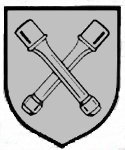
Insignia of the Dirlewanger Brigade
It included, among others:
- special SS regiment "Dirlewanger" (SS-Sonderregiment) with subordinated to it: the 3rd company of the 111th Azerbaijani regiment and the 1.Ostmuslemanische SS-Regiment (without the 3rd battalion)
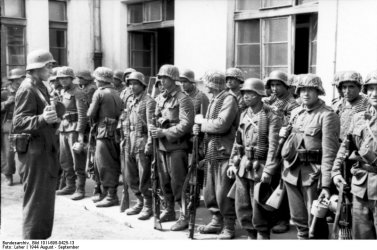
Soldiers of the 111th Azerbaijani regiment
- strengthened Azerbaijani 2nd battalion of the Special Group Bergmann (without the 7th company), 1st and 2nd companies of the 111th Azerbaijani regiment and half of the platoon of the 4th heavy machine gun company from the 111th Azerbaijani regiment,
- 2nd and 4th company of the gendarmerie from Einsatzkommando Walter,
Azerbaijani units were mainly on the first combat line in the Dirlewanger Assault Group.
The soldiers of the Dirlewanger regiment were recruited from German prisoners convicted of poaching, criminal detainees, prisoners of Auschwitz, Dachau and Sachsenhausen concentration camps (including political prisoners), Wehrmacht and SS soldiers in strict detention regime. Later the squads were also supplemented with Russians and Ukrainians. There was an iron discipline in the unit.
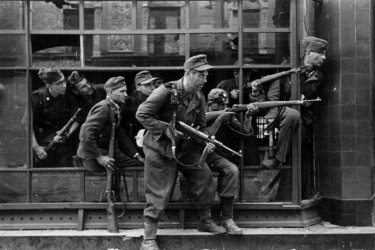
Soldiers of the Dirlewanger Brigade
After the arrival on August 4, 1944 Dirlewanger's units attacked Wola, the western district of Warsaw. After breaking the defence of the weakly armed insurgent troops, the Germans along with the Asian allies proceeded to massacre the defenceless inhabitants of the district. About 50,000 people were murdered within a few days: unarmed civilians - men, women and children. Victims were buried in makeshift collective graves or burned on piles. The Azeris often burned their victims alive or cut the throats of their victims with khanjalis. This cruelty was surprising even for the German command. Some associated it with their Muslim origins, hostile to Christianity.
The combat route of the Dirlewanger units was leading from the railway embankment (along the current Prymasa Tysiąclecia Avenue) by Kercelak, Górczewska, Wolska, Karolkowa, Ogrodowa Streets, including the courts building in the Leszno Street, Streets: Chłodna, Elektoralna and Krochmalna through Hale Mirowskie, Mirowski Square and Żelazna Brama.
On August 6 the SS-Sonderregiment reached the Saxon Garden and the Brühl Palace, where the commander of the Warsaw garrison (Stadtkommandant Warschau) general Reiner Stahel was surrounded. Then it strengthened the border along Senatorska Street and Teatralny Square and attacked through Bednarska and Karowa Streets, reaching Dobra Street to the corner house (No. 47) with Karowa Street. At the same time the regiment reached Bank Square and unsuccessfully attacked the barricade at Bielańska Street and the buildings of the Town Hall and Blank Palace. It also took control over some of the destroyed complex of the Royal Castle and took positions on the Vistula River to the Boleść and Rybaki Streets.
Dirlewanger's unit was fighting for two weeks in tough battles for the Town Hall, the ruins of the Royal Castle and the St. John's Archcathedral.
On September 1, 1944 SS-Sonderregiment Dirlewanger attacked through Kanonia, Piwna and Świętojańska Streets and reached the Old Town Square, Nowomiejska Street and Krzywe Koło Street, which effectively ended the defence of the Old Town. The Waffen SS (including soldiers form Turkestan Legion subordinated to Dirlewanger) murdered the wounded in hospitals at 7 Długa Street, 10 Freta Street, 1/3 Kilińskiego Street and 24 Miodowa Street, as well as on 25 and 46 Podwale Street.
Then the soldiers of the Dirlewanger Assault Group broke the defence of the insurgents of the "Krybar" grouping in Powiśle and fought between Świętokrzyska and Chmielna Streets, stopping on 7th September on Warecka Street. On September 10 they reached the area of the National Museum and assaulted along Książęca and Ludna Streets.
On the night of 12th to 13th September SS-Sonderregiment Dirlewanger cut Czerniaków from the city centre, where until 23 September it fought tough fights with the insurgents of the "Kryska" grouping and the remnants of the "Radosław" grouping.
In battles with the insurgent units, the SS-Sonderregiment Dirlewanger suffered huge losses. When it came to Warsaw, it consisted of 881 soldiers and officers. During the battles it received a replenishment of 2,500 soldiers, the final state on October 1 was 648 soldiers. In the battles, 2733 were killed, and the losses amounted to 315%.
Units created from non-Slavonic nationalities (the nations of the Caucasus and Soviet Central Asia) were called the Eastern Legions (Ostlegionen). Warsaw residents called them Mongols or Kalmyks.
In the Dirlewanger Assault Group, the SS-Sonderregiment was constantly supported by Azeri and Turkmen allies.
In October 1941 the Germans decided to create a military unit from Soviet prisoners of war from the Caucasus. A unit consisting of Georgians, Azerbaijanis and Armenians was created from the former soldiers of the Red Army, selected from the POW camps. In 1942 the division grew to the size of the regiment of the Special Group Bergmann (Sonderverband Bergmann) consisting of three battalions: Georgian, Azeri, and North Caucasian.
The 2nd Sonderverband Bergmann battalion composed of about 500 people under the command of Lieutenant Bertelsmann, became a part of the Reinefarth Combat Group and participated in the suppression of the Warsaw Uprising. The unofficial badge of the Sonderverband Bergmann soldiers was a dagger, worn on the left side of the mountain cap.
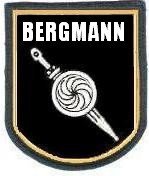
Insignia of Sonderverband Bergmann
The Dirlewanger Group also included I/111 Azerbaijani Field Battalion "Dönmec" (Aserbeidschanische Feld Bataillon I/111 "Dönmec"). The unit formed in occupied Ukraine in 1942 was formally part of the Azeri Legion.
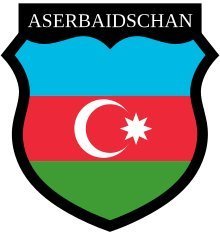
Patch of the Azerbaijani Legion
It became a part of the 111th Infantry Division commanded by General Hermann Recknagel as the 1st Battalion.
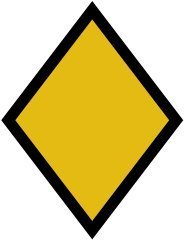
Insignia of 111th Infantry Division
In the first half of 1944, reaching about 650 people, it was deployed to the area of Warsaw. Being a part of the Dirlewanger Assault Group it took part in the massacre of civilians in Wola.
The 1. Ostmuslemanische SS-Regiment also operated within the Dirlewanger Assault Group. It was formed in January 1944 in a training camp in Trawniki in the area of the General Governorship. It consisted of the soldiers of the dissolved Wehrmacht Turkestan Battalions and prisoners of war from the Red Army and forced labourers working in Germany. They were Turkmen, Azeris, Kyrgyz, Uzbeks and Tajiks.
The regiment's soldiers wore Waffen-SS uniforms with an armband "Osttürkische Waffen-Verband der SS" and standard SS eagles on the sleeve. In addition, the regiment's soldiers wore special black and white patches with a wolf's head.
An armband and a patch of 1. Ostmuslemanische SS-Regiment
In August and September this unit reaching approximately 4 thousand people under the command of SS-Sturmbannführer der Reserve Franz Libermann and then SS-Hauptsturmführer Reiner Olzschy brutally pacified Warsaw citizens during the Warsaw Uprising.
Azeri troops suffered heavy losses in the fight against insurgents, in some of them exceeding 50% casualties.
Against the insurgents fought also the 830th battalion of the Volga Tatars established as a part of the Volga-Tatar Legion in January 1942 in Radom. The battalion was then incorporated to the Wehrmacht unit.
Cossack units constituted the largest ethnic group among foreigners fighting against the insurgents. The Cossacks, who did not identify themselves with Ukraine, came mainly from the lands between Don, Kuban and Ural. They considered themselves a separate nation.
Insignia of the Cossack units
Some of the Cossack units were stationing in Warsaw before the uprising. It were:
- Cossack company stationed at 9 and 21 Aleja Szucha
- 209. Cossack Schutzmannschaften battalion (Schuma - auxiliary police) formed in Warsaw from independent companies three months before the Uprising. Mainly Siberian Cossacks. Rohr Group.
After the outbreak of the Uprising, numerous Cossack "Rescue units" were sent to Warsaw which became part of the Korpsgruppe von dem Bach.
3rd Kuban Cossack Regiment, commander Colonel Bondarenko, state 22 officers/551 soldiers, initially took part in the slaughter of Wola supporting the Dirlewanger Assault Group, later it was moved to a group separating the insurgents from the partisans in the Kampinos Forest.
69th Cossack Unit, commander Lieutenant Schlachtermund, state 14 officers/759 soldiers, initially worked with the Dirlewanger Assault Group in the Reinefarth Combat Group, then moved to the separating group.
572nd Battalion of the Cossack infantry, commander Colonel Zinoviev, state 14 officers/605 soldiers, took part in the battles for the Old Town, Czerniaków, and Żoliborz. The soldiers wore a patch of Don Cossacks on their uniforms.
4th Squadron of the 580th Eastern Cavalry Division, commander captain Kalamorz, about 160 people, took part in the battles for the Old Town, Czerniaków, and Żoliborz. For participating in the battles captain E. Kalamorz was awarded the Golden German Cross on September 1.
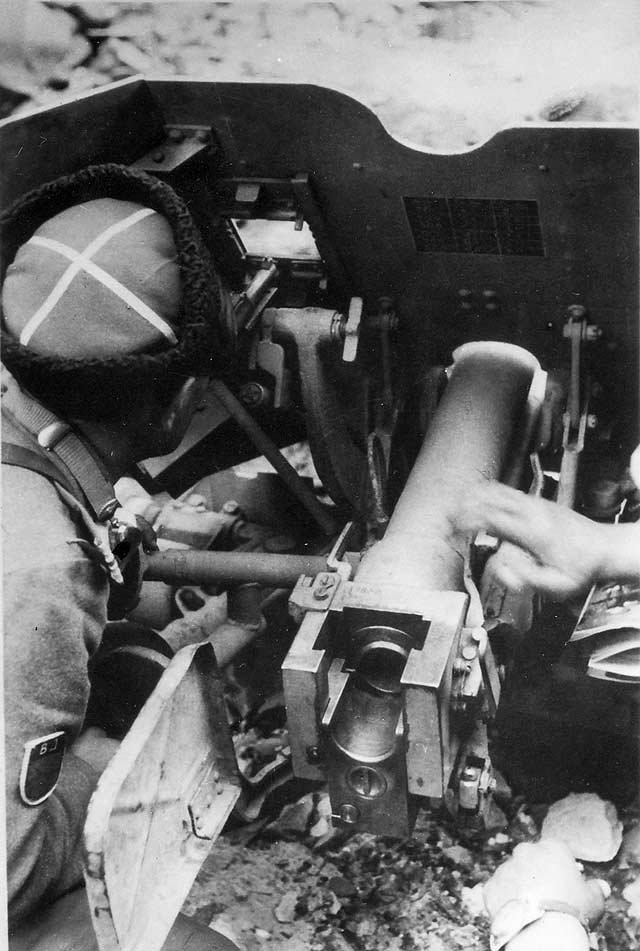
Cossack soldier operating a gun
Units sent to the group separating the insurgents from the Kampinos Forest from the "Żywiciel" grouping from Żoliborz:
- 4th Battalion of the 57th Cossack Security Regiment, 8/936
- 579th Cossack Squadron,
- 631st Cossack Battalion, about 1,100 people.
In total a few thousand Cossacks, actively participating in the pacification of the city, could be found in Warsaw and its surroundings.
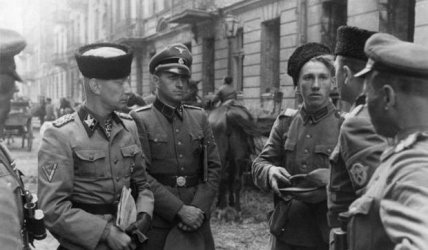
General Reinefhart (on the left) with Cossack officers
Less numerous, although equally significant contribution to the pacification of the Warsaw Uprising had the Ukrainians. The Ukrainians served in Ukrainian as well as Russian and mixed German-Ukrainian formations. Among them were the inhabitants of both Western Ukraine (being before the war a part of the Republic of Poland) and the Russian-speaking Eastern Ukraine. The first ones knew the Polish language very well.
In Warsaw, before the Uprising, there were two Ukrainian police companies (probably part of the Ukrainian Waffen SS Division Galizien-Hałyczyna), the Ukrainian formation was in the Pawiak prison guard, and groups of Ukrainians in the Hiwis units. After the outbreak of the uprising, the 34th police regiment was also sent to Warsaw, including the 1st German battalion and two German-Ukrainian battalions.
To the SS unit occupying the building of the Higher School of Political Sciences at Wawelska Street a company of Ukrainians was incorporated. Also in the Schutzpolizei battle group (1,700 soldiers) was a group of Ukrainians (150 soldiers) quartering in Aleja Róż Street under numbers 9 and 25. After the outbreak of the Uprising, some of them attempted to break through Śródmieście towards the Saski Garden using cars. At Marszałkowska Street, their cars were destroyed by the insurgents' gun fire. Ukrainians hid in nearby houses, where they murdered many residents, including women and children, before they were killed by organized groups of insurgents.
The Ukrainians, probably all from the Russian Ukraine, constituted a large percentage in the Russian and Cossack units suppressing the Uprising. They were in the RONA regiment (Russian National Liberation Army), commanded by B. Kaminski.
The Ukrainians from 1943 were also supplementing the SS Special Regiment Dirlewanger commanded by Oskar Dirlewanger, assigned to the police group commanded by Heinz Reinefarth, which was despatched by Heinrich Himmler to suppress the Warsaw Uprising.
From September 15, the Volhynian Legion, called officially by the Germans 31. Schutzmannschafts-Bataillon der SD fought in Powiśle and Czerniaków. The Legion in number of about 400 men fought from 15th to 23rd September 1944 in Czerniaków with the insurgents of the "Kryska" and "Radosław" groupings. It also fought with the 9th Regiment of Infantry from 3rd Romuald Traugutt Pomeranian Infantry Division of the Polish First Army, which rushed to help the insurgents, and then took part in the operation "Sternschuppe" (27-30 September 1944) against the grouping of the Home Army in the Kampinos Forest.
The Volhynian Legion, whose soldiers previously took part in slaughtering Poles in Volhynia (in 1943-44), was commanded by colonel Petro Diachenko, a pre-war contract officer of the Polish Army.
Many soldiers from the Russian units suppresing the Uprising admitted that they were Ukrainians. They were from the Russian-Cossack formations, stationed in the former fire station at Chłodna Street, in the buildings of the former Szkoła Gazowa (school of chemical weapons) on Gdańska Street and in the buildings of the former vocational school in Bielany.
The Ukrainian division Waffen SS Galizien (Hałyczyna) did not participate in the suppression of the Warsaw Uprising. However, the fact is that the 150-person Ukrainian police company, stationed at Aleja Szucha, was part of the SS Galizien. In addition, 10 Ukrainian officers cadets from the 14th Grenadier Division of the SS "Galizien" trained in the Poznan SS Junkerschule Braunschweig Officers School in Posen-Treskau were in the alarm mode sent to Kampfgruppe "Reinefarth", where they served as translators.
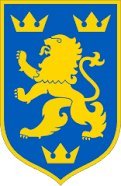
Insignia of the SS-Galizien division
The Ukrainian soldiers behaved extremely cruelly, they committed a lot of monstrous crimes especially against civilians. They were credited with all the crimes and wickedness committed by Slavic soldiers serving in the German army during the Uprising. The information about the Volhynian slaughter carried out on the Polish population by the neighbouring Ukrainians in the years 1943-1944 certainly had a big impact on this.
Ukrainians also took an active part in the destruction and plunder of Warsaw after the capitulation of the Warsaw Uprising in the period of October 1944 - January 1945.
In the German troops also fought the Belarusians. The Belarusian 13th Sipo auxiliary battalion under the command of SS-Hauptsturmführer Kurt Junker stationed from August 3 to September 13 1944 in the SS offices at Aleja Szucha, Aleja Róż, Ujazdowskie, and on Koszykowa and Wiejska Streets in the German police district. For participation in the battles with the insurgents Oberfeldfebel (senior sergeant) Ilja Sanetz was honoured as the first in the battalion with an Ostvolk Medal in gold with swords for courage. Later, the Belarusians were still fighting in the lower Mokotów district.
The back of Korpsgruppe von dem Bach was secured by 532. Rückwärtigen Armeegebietes under the command of General Bernhard. The 252. Lithuanian battalion, among others, was subordinated to it. Also some individual Latvians in the of German formations took part in the fights during the Warsaw Uprising.
One can assume that the subject of foreign German collaborators in the Warsaw Uprising has already been exhausted. It turned out, however, that there are additional facts. The Norwegian writer, Erik Veum, in 2009 published the book "Those Who Fell." It describes the fate of 836 Norwegians who fought in Nazi uniforms during World War II. It shows that at least 20 young Norwegians fought in the Warsaw Uprising in the SS Roentgensturmbann division in the Recka Strike Group, which was directed to fight in the Polish capital. They received an order to "kill everyone who stands in their way, whether it is a child, a nun, or a war invalid." Three of them were killed by insurgent bullets. Veum claims that four of his countrymen also fought in the formation of SS Oscar Dirlewanger, which was famous for its exceptional barbarism, and its soldiers are responsible of the most terrifying crimes in the Uprising.
To soldiers of collaborative units composed of former citizens of the Soviet Union, residents of Warsaw referred as "Ukrainians" "Kalmyks" or "Vlasov's men". "The Kalmyks" meant representatives of the Azeris, Tatars and other Caucasian nations. "Ukrainians" meant soldiers in German uniforms using Russian or Ukrainian language. A similar abbreviation was the word "Vlasov's man".
Warsaw residents did not distinguish subtleties concerning the language and patches on uniforms of soldiers from collaborative formations of Slavonic origin. One of them is POA (Russian Liberation Army - ROA), the other is POHA (Russian National Liberation Army - RONA).
Sleeve shields of ROA and RONA
POA patches were used by many Russian-speaking formations, including Cossack ones. In April and May 1943, the German Oberkommando des Heeres (OKH) issued orders introducing ROA badges on the uniforms of soldiers of all Russian military formations fighting on the side of the German troops. They were also to be worn by Hiwi (Hilfswillige - auxiliary services of the Wehrmacht composed of former prisoners of the Red Army and Soviet civilians). The badge could be worn on the left or the right sleeve of the uniform above the elbow. This was to serve the purpose of evoking the impression of the mass numbers of the ROA, because several hundred thousand Soviet citizens joined with the Germans. It is estimated that ROA patches could be worn by up to 800,000. Russians and representatives of other nationalities (mainly Cossacks, but also Ukrainians or representatives of Central Asian nations) in the service of the German army.
Maciej Janaszek-Seydlitz
POHA is the symbol of the SS Kaminski Assault Brigade, which was one of the most flagitious German troops in the Warsaw Uprising. The soldiers of General Vlasov were not present in the uprising, because the Vlasov army was not yet existing formally at that time. It was established just at the end of 1944, after the fall of the Warsaw Uprising. At that time, some of the troops wearing ROA patches were subordinated to Gen. Andrei Vlasov, who cooperated with the Germany as a part of the KONR (Armed Forces of the Committee for the Liberation of the Peoples of Russia). The majority of soldiers of the RONA Assault Brigade, transformed into the 29th Grenadier Division of the SS were transferred to KOHP.
The black legend of the Vlasov's men was for years supported by the communist authorities in order to discredit the memory of General Andrey Vlasov and his soldiers who stood against Stalin and the Soviet Union.
In the Warsaw Uprising of 1944, the Hungarian troops also appeared as an ally on the German side. However, the behaviour of Hungarian soldiers differed fundamentally from the remaining collaborators of Nazi Germany.
After the outbreak of the Uprising, the Germans brought to Warsaw the troops of the Hungarian 2nd reserve corps, commanded by General Antal Vattay. The command of the 9th Army hoped that the Hungarian corps would strengthen the cordon surrounding Warsaw.
On August 9, the 23rd Reserve Division reached the city, and between 15th and 20th August the 1st Honvédség Cavalry Division, 5th and 12th Reserve Divisions along with the staff of the Corps arrived in. In total, around 25,000 Hungarian soldiers arrived in near Warsaw.
It soon turned out, however, that the Hungarians were openly sympathetic to the Poles. Hungarian posts were letting through Polish partisan units heading to the city, and the corps officers even negotiated with the Home Army command to change the alliance and to jointly stand against the Germans.
Approximately 40 Hungarians from 106th company from 12th division joined the Polish Home Army Grouping "Kampinos". It was a working company composed of Hungarian Jews. The interviews with Hungarian soldiers were conducted by Polish insurgents from Mokotów, Sadyba and Lasy Chojnowskie. They received from them an assurance of friendship between the two nations, as well as a certain amount of weapons.
On August 23, Hungarian formations located south of Mokotów sent fighting Poles warnings of German actions. The insurgents received important information that the Nazis were preparing for the attack in Służewiec and Wilanów. Thanks to this, the Poles had time to regroup and effectively resist the enemy. Hungarian soldiers painted their country's flags on their tanks so that they would not be attacked by the insurgents. A number of Hungarians went to the side of the insurgents.
On September 29 1944, in the final phase of the battle at Jaktorów, the insurgent Homeland Army grouping "Kampinos" retreating to the Świętokrzyskie Mountains was surrounded by the German forces and destroyed. In this region, a Hungarian unit from the 1st Hon. Division was commanded by Rotmist Miklós Bodócs.
During the battle, the Hungarians took en masse Polish partisans into captivity. They treated their wounds, fed them, and then let them go slowly, warning them of the stationing German troops. Poles received food, cigarettes and even ammunition for the road. They refused to give Polish prisoners to Germans, saving lives of almost 100 Poles.
In this battle two Hungarian soldiers, who had previously joined the Polish partisan grouping, died. They are buried at the War Cemetery in Budy Zosine.
The Germans did not trust their Hungarian allies. They were overhearing phone calls of the Hungarian troops stationed in Poland, arrested soldiers from the Danube River, and even shot several Hungarian soldiers.
In this situation, the German command was forced to abandon the use of the Hungarian corps against the insurgents. By September 10, troops from the 12th and 23rd division and the command of the 2nd Hungarian Corps were withdrawn from Warsaw. On the frontline was still 1 Hon. Division and 5th Division in Piaseczno, which was stationed there until October 1944.
In 2017 at Matejki Street in Warsaw, in a short distance from the building of the Sejm of the Republic of Poland, a monument dedicated to the memory of the Hungarian Honvédség, who supported the Warsaw Insurgents, was unveiled.
translated by: Maciej Liszewski
Copyright © 2019 Maciej Janaszek-Seydlitz. All rights reserved.